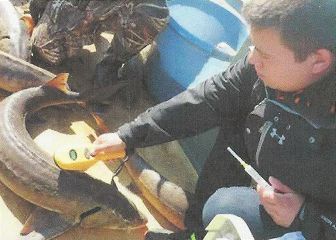 |
Canku Ota
|
 |
|
(Many Paths)
|
||
|
An Online Newsletter
Celebrating Native America
|
||
|
September 2015 - Volume
13 Number 9
|
||
|
|
||
|
For The Love Of Sturgeon!
|
||
|
by Jessica L. Jock,
Program Manager, St. Lawrence River AOC
|
||
Staff from the Saint Regis Mohawk Tribe’s (SRMT) Environment Division have been busy this spring applying both traditional and scientific knowledge in teachings to apprentices, and collaborating with state and federal resource agencies for holistic lake sturgeon restoration efforts in Akwesasne and surrounding environments. Environment Division staff goals include maintaining and building a sustainable lake sturgeon population for the community of Akwesasne through fish monitoring, spawning habitat enhancement, and lake sturgeon rearing activities. This objective has been facilitated through 2010 funding from United States Environmental Protection Agency (USEPA) Great Lakes Restoration Initiative (GLRI) to SRMT for lake sturgeon restoration. Lake sturgeon, Teiokién:taron, is a culturally-significant species. Lake sturgeon are known by elders for their size, strength, and longevity, as well as a vital protein source for sustenance. The practice of collective sharing of smoked sturgeon in the family and community is still an important cultural practice in Akwesasne that continues today. The practice of sturgeon fishing is preserved by a few Mohawk knowledge holders in Akwesasne, passed down through generations. Sturgeon fishing is reserved to Native people in Canadian waters, and protected by the James Bay and Northern Quebec Agreement (1975). Lake sturgeon, are the largest and longest lived fish species native to the Great Lakes watershed. During the colonial settlements, these fish were once killed as a nuisance by non-Natives. After the mid-1800’s, settlers realized that the sturgeon flesh and roe (eggs) was a valuable resource, and smoked sturgeon and caviar became very popular and sold in New York City. Today, this activity is illegal in New York State (NYS).
The New York State Department of Environmental Conservation (NYSDEC) closed the sturgeon fishery in 1976 and listed the fish as a New York State threatened species in 1983. It has remained on the list since. Lake sturgeon are also listed as threatened” in the provinces of Ontario and Quebec. In 2006, the Committee on the State of Endangered Wildlife in Canada (COSEWIC) suggested a status change from “special concern” to “threatened” for the lake sturgeon species in the waters of the St. Lawrence River between the Moses-Saunders Dam and Beauharnais Power Dam, including Lake St. Francis and Akwesasne waters. Currently, Fisheries and Oceans Canada is reviewing this suggested status change under the Species at Risk Act (SARA). Despite recent reduced fishing pressures and State and Provincial protection, lake sturgeon populations have yet to rebound. Teiokién:taron are long-lived, and females don’t reach sexual maturity until 14-23 years of age, and only spawn every four to six years. Spawning female sturgeon can live up to 150 years in the wild, grow up to seven feet in length, weigh up to 200-300 lbs, and carry 30 lbs. of roe during spawning years! Lake sturgeon’s late age of maturity and periodic spawning have contributed to the species rapid decline and slow recovery. This is why it is important to preserve the spawning females in the wild, and encourage successful reproduction through egg rearing activities through fish hatcheries and scientific intervention. SRMT’s Environment Division Master Teachers of the Akwesasne Cultural Restoration (ACR) Program, Environmental Specialists of the St. Lawrence River Area of Concern (AOC) and Water Resources Programs have been collaborating amongst offices and with state and federal resource agencies to promote sustainable lake sturgeon practices.
In May, ACR and AOC staff collaborated in the field to take morphometric measurements (length, weight, girth) of fish captured and released. Apprentices learned the scientific techniques of Passive Integrated Transponder (PIT) tagging to assist long-term monitoring of lake sturgeon populations in the environment. ACR Masters also taught apprentices lake sturgeon fishing, fish smoking practices, and associated conservation lessons based on Haudenosaunee traditional environmental stewardship principles and teachings. For precautionary measures, all presumed and identified females were released. On June 2, Environment Division ACR, AOC, and Water Resource Management staff participated in the lake sturgeon egg take, an annual effort lead by NYSDEC Fisheries, Region 6. This effort was conducted in collaboration with United States Fish and Wildlife Service (USFWS)-Genoa National Fish Hatchery and the New York Field Office. Other participants included the United States Geological Service (USGS), Great Lakes Science Center Cortland Office and the Akwesasne Freedom School (AFS) students and staff. This activity involves harvesting male and female gametes for assisted reproduction activities, assessment of reproductive health, and ensuring fertilized egg viability for transport to fish hatcheries. All parent fish are released safely back to the St. Lawrence River, and we wait until fall for the young of year sturgeon to return ‘home’! |
||||||
|
|
|
|
||
|
|
||
| Canku Ota is a free Newsletter celebrating Native America, its traditions and accomplishments . We do not provide subscriber or visitor names to anyone. Some articles presented in Canku Ota may contain copyright material. We have received appropriate permissions for republishing any articles. Material appearing here is distributed without profit or monetary gain to those who have expressed an interest. This is in accordance with Title 17 U.S.C. Section 107. | ||
|
Canku Ota is a copyright ©
2000 - 2015 of Vicki Williams Barry and Paul Barry.
|
||
 |
 |
|
|
The "Canku
Ota - A Newsletter Celebrating Native America" web site and
its design is the
|
||
|
Copyright ©
1999 - 2015 of Paul C. Barry.
|
||
|
All Rights Reserved.
|
||


